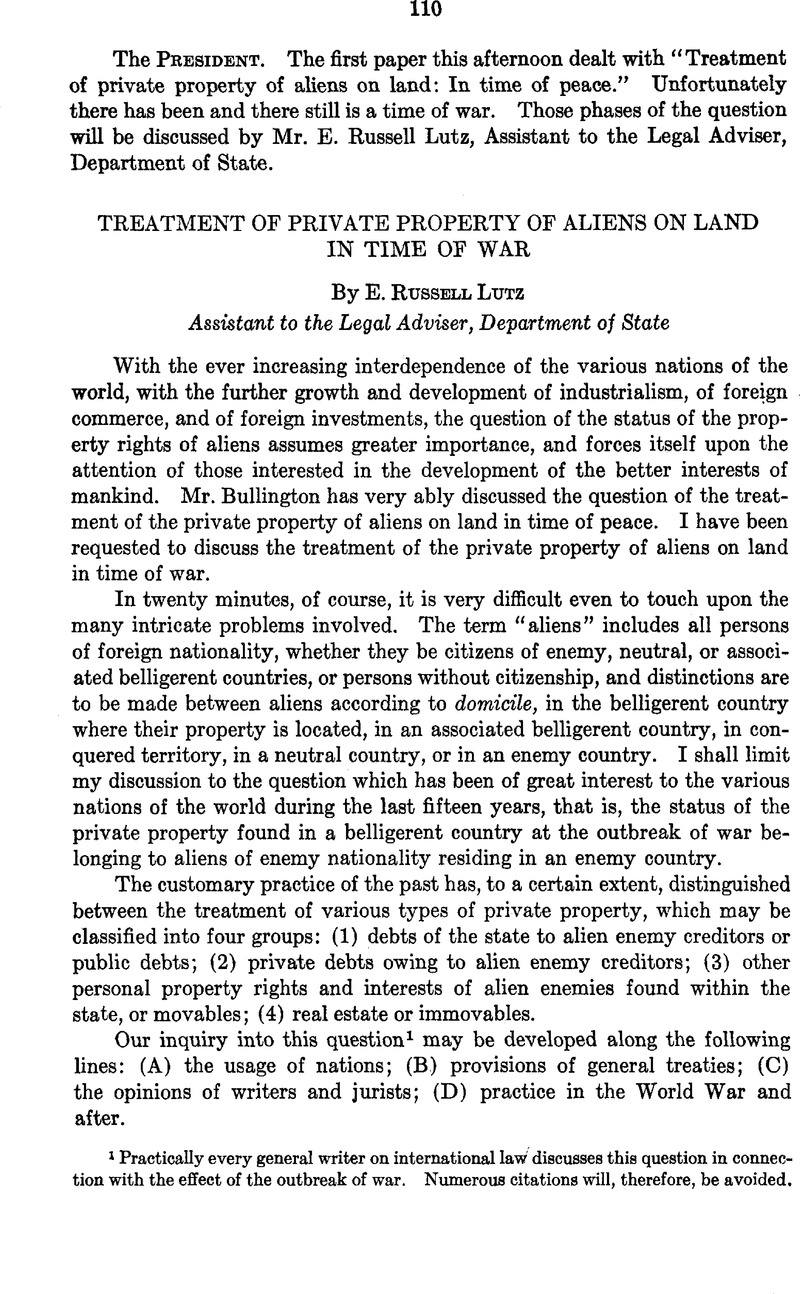Article contents
Treatment of Private Property of Aliens on Land in Time of War
Published online by Cambridge University Press: 27 February 2017
Abstract

- Type
- Third Session
- Information
- Proceedings of the American Society of International Law at its annual meeting (1921-1969) , Volume 27 , 1933 , pp. 110 - 127
- Copyright
- Copyright © American Society of International Law 1933
References
1 Practically every general writer on international law discusses this question in connection with the effect of the outbreak of war. Numerous citations will, therefore, be avoided.
2 Westlake, International Law, p. 44.
3 Quaestionum Juris Publici, Vol. II (Translation), Classics of International Law, 1930, pp. 25, 49–51.
4 Wheaton, International Law, Dana ed., p. 378; Classics of International Law, Vattel, Le Droit des Gans, Vol. II, Classics of International Law, 1916, p. 139; Hall, International Law, 8th ed., p. 521; Moore, Digest of International Law, Vol. VII, pp. 306–307.
5 Westlake, op. cit., p. 46 note.
6 J. B. Moore, International Law and Some Current Illusions, pp. 13–15 (hereinafter cited as “Current Illusions”); Ware v. Hylton (1796), 3 Dallas 199.
7 Dana’s Wheaton, op. cit., p. 390.
8 See Wolff v. Oxhoim (1817), 6 M. & S. 92.
9 McPherson, Political History of the United States during the Great Rebellion (4th ed.), p. 198.
10 Spaight, War Rights on Land, p. 31. See Parl. Papers, Vols. I and II, N. A., No. 1, 108.
11 Turlington, American Journal of International Law, Vol. 27 (1928), p. 270, at pp. 284–287.
12 Moore’s Digest, VII, pp. 290-295; 23 Columbia Law Review, 383; Hyde, International Law, II, p. 238.
13 Spaight, op. cit., p. 32.
14 Bynkershoek, op. cit., pp.22–23; Twiss, Law of Nations, Secs. 47, 49, 50; Hall, op. cit., pp. 522–523, 525; Westlake, op. cit., p. 45; see Works of Alexander Hamilton, Lodge’s ed., Vol. V, pp. 160, 412–418; Turlington, op. cit.
15 Westlake, op. cit., p. 46.
16 Current Illusions, p. 21.
17 E. M. Borchard in A. J. I. L., Vol. 27 (1928), p. 636 at p. 640.
18 Grotius, De Jure Belli ac Pacis, Vol. II, Classics of International Law, 1925, pp. 757–759.
19 Bynkershoek, op. cit., pp. 22, 29, 31, 32.
20 Vattel, op. cit., pp. 25, 260.
21 A., Rivier, Principes du Droit des Gens (1896), Tome II, p. 232 Google Scholar.
22 See, for example, the opinions collected in VII Moore’s Digest, pp. 306–309.
23 See, for example, Claud Mullins, “Private Enemy Property,” Transactions of the Grotius Society, Vol. VIII, pp. 89-104; dicta of Justices Chase, Iredell and Cushing in Ware v. Hylton (1796), 3 Da11. 199, and dissenting opinion of Justice Story in Brown v. United States (1814), 8 Cranch 110; Mr. Justice Strong in Miller v. U. S, (1870), 11 Wall. 268; Lord Sterndale in Ex-Tzar of Bulgaria (1921), 1 Ch. 107.
24 (1796) 3 Da11. 199.
25 (1814) 8 Cranch, 110.
26 Kent’s Commentaries on American Law, Vol. I, pp. 59, 63–65; Justice Wilson in Ware v. Hylton, supra; Justice Clifford in Hanger v. Abbott (1869), 6 Wall. 532, 536.
27 1833, 7 Pet. 51, 86.
28 Moore’s Digest, VII, pp. 312–313; Moore, Current Illusions, pp. 13–25; Westlake, International Law (1910), Vol. II, pp. 41–48; Oppenheim, International Law, 3rd ed., Vol. II, pp. 157–158; Lawrence, The Principles of International Law (1910 ed.), pp. 425–429; see also 21 Columbia Law Review, pp. 666, 669 note 14; Borchard, in A. J. I. L., Vol. 18 (1924), pp. 523–532, and Vol. 22 (1928), pp. 636–641; Hyde, International Law, Vol. II, pp. 237–242; Lord Parker in The Roumanian (1916), 1 A. C. 124.
29 For some of the laws, see Fauchille, Trait de Droit International Public (1921), Vol. II, pp. 73–74.
30 British Command Paper, No. 8271, 1916. Recommendations of the Economic Conference of the Allies, held at Paris on June 14, 15, 16 and 17, 1916.
31 See Temperley, History of the Peace Conference, Vol. II, 327,328 ff., Vol. V, pp. 86–91.
32 The Secretary of the Treasury, in 1926, declared: “To confiscate the private property of enemy citizens is inconsistent with historical American policy, detrimental to our own citizens who have interests abroad, and above all wrong in morals.” New York World, April 22, 1926.
33 American Foreign Relations, 1930, Charles P. Howland, Editor, section entitled “Notes on the Policies of Various Allied Powers and Colonies in Dealing with Sequestrated Enemy Property,” pp. 508–519; and Chapter 3 and “Alien Enemy Property,” pp. 482–508.
34 Young Report, Chap. IX, entitled “Liquidation of the Past.”
35 Report of 33rd Conference, p. 73.
36 Report of 36th Conference, p. 363.
37 Charles Bernard, Swiss publicist, has published the opinions of many prominent persons, in two volumes entitled Le Sequestre de la Propriete Priv& en Temps de Guerre (1927–1930, Paris, Marcel Giard).
- 1
- Cited by




